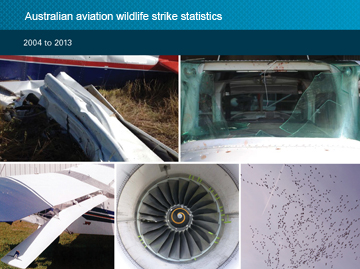
The rate that aircraft are striking wildlife has reduced in the past two years following four years’ of growth.
Birdstrikes are the most common aviation occurrence and continue to be a significant economic risk for aerodrome and airline operators and a potential safety risk for pilots.
More than 1,500 birdstrikes are reported to the ATSB each year. Most involve high-capacity air transport aircraft. However, since 2011, the birdstrike rate per aircraft movement for seven of the 10 major airports has reduced. Adelaide, Melbourne, Perth and Sydney had lower rates in 2013 than in 2004.
The ATSB’s latest biannual update of aviation wildlife strike statistics shows that although the number of birdstrikes has continued to increase for all operation types, due to increasing aircraft movements, the rate per aircraft movement has actually decreased slightly in recent years.
Domestic high-capacity air transport aircraft were those most often involved in birdstrikes, and the strike rate per aircraft movement for these aircraft was significantly higher than all other categories. However, the number of the incidents with the potential for more serious consequences due to engine ingestion is at its lowest level in 10 years.
There were 3,400 birdstrikes in 2012–13, with the four most commonly struck wildlife being kites, bats/flying foxes, lapwings/plovers and galahs.
Kites had the most significant increase in the number of reported strikes per year in the past two years, with the species being involved in an average of 129 strikes per year for 2012 and 2013, compared with 84 per year on average across the entire 10-year reporting period.
Historically, birdstrikes have not been a significant safety risk to civilian air travel in Australia. ATSB data dating to 1969 shows no civilian aviation fatalities attributed to birdstrikes.
Compared to birdstrikes, non-flying animal strikes are relatively rare. The most common animals involved were hares and rabbits, kangaroos, dogs/foxes and wallabies. Damaging strikes mostly involved kangaroos, wallabies and livestock.
“The statistics provide a reminder to everyone involved in the operation of aircraft and aerodromes to be aware of the hazards posed to aircraft by birds and non-flying animals,” ATSB Chief Commissioner Martin Dolan said.
Read the full report: Australian aviation wildlife strike statistics 2004 - 2013


